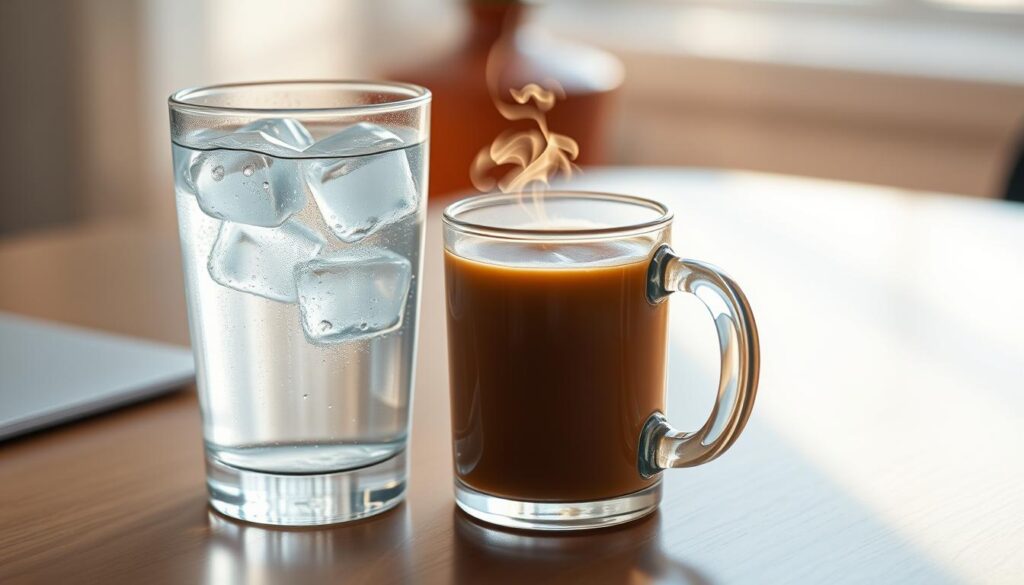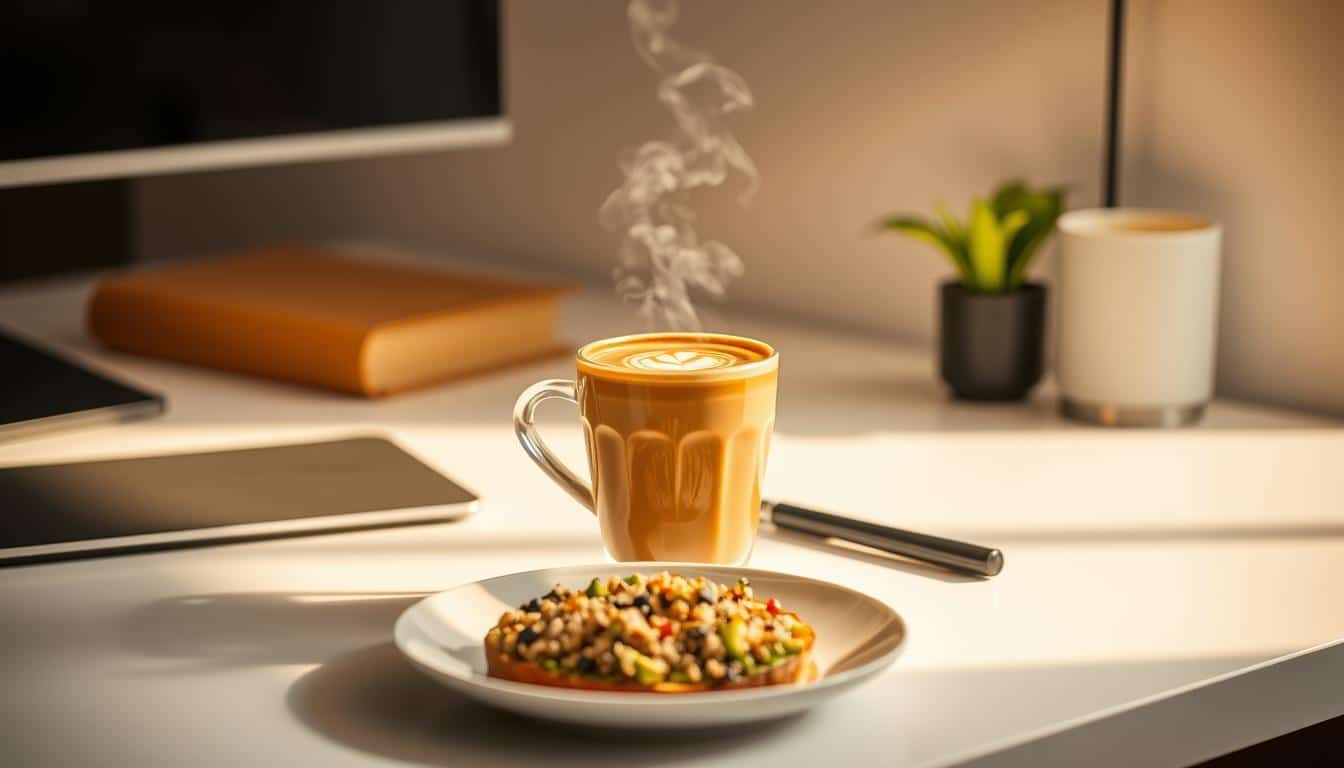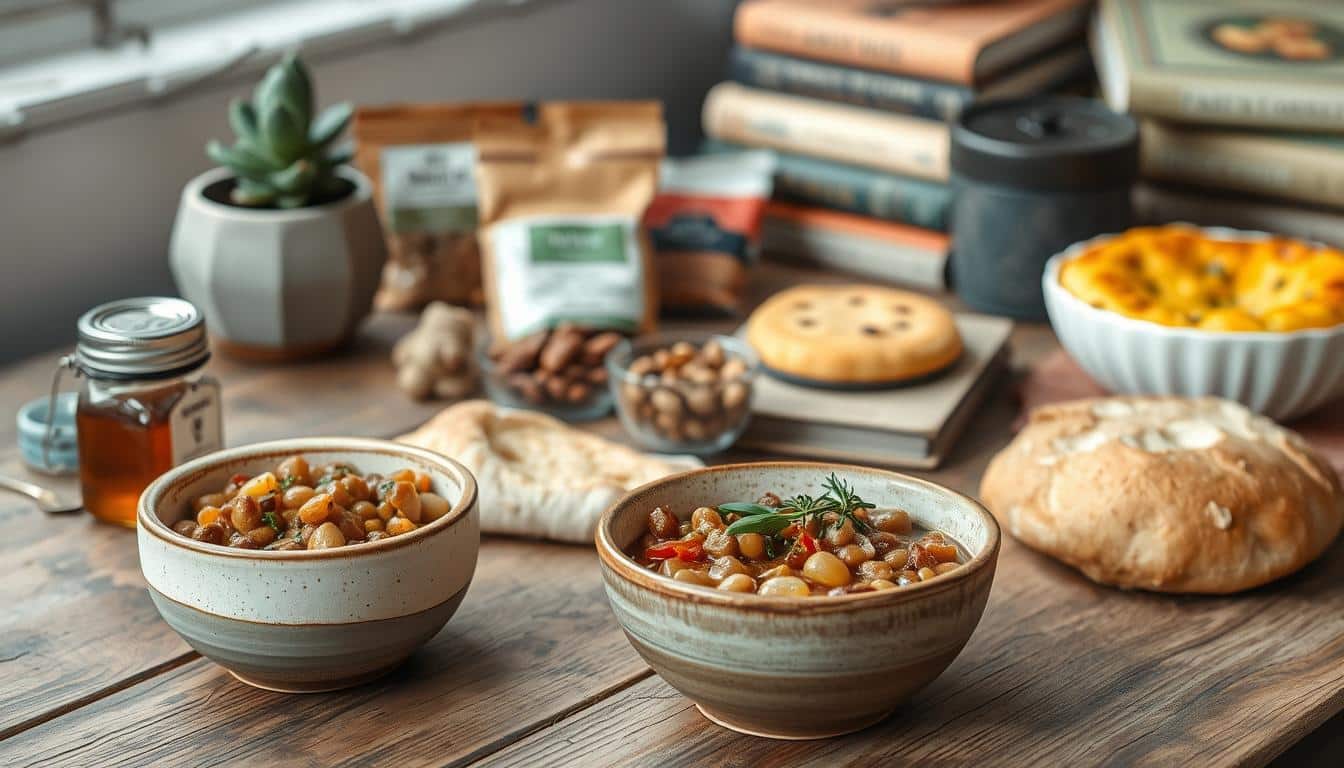In today’s fast work world, mixing caffeine with one-cup meals boosts work speed and focus. The right mix of caffeine and healthy food lifts your energy and thinking power. This lets you handle work better. Learning how these pairings help you shows how to make the most of coffee breaks and meal times. Find out how small changes can make the most of caffeine’s perks in work life.
The Science Behind Caffeine Boosts
Caffeine is popular for boosting alertness and mental sharpness. It has a big impact on the brain and helps manage fatigue. It works by stopping adenosine from making us feel sleepy, improving our thinking and productivity.
How Caffeine Affects Cognitive Function
Caffeine helps the brain work better in several ways. It makes you happier and quicker to react by increasing dopamine. People who drink caffeine do better on tasks and think more clearly.
This is really helpful when you’re tired and need to stay sharp. Staying alert helps make work time more productive.
The Role of Adenosine in Fatigue
Adenosine makes you want to sleep and signals when you’re tired. It slows down brain activity when it connects to its spots. Caffeine keeps this from happening, so you don’t feel as sleepy.
This helps you stay awake and alert when you really need to. Knowing how caffeine works against adenosine can help you stay energized all day.
Caffeine and Its Popular Sources
Caffeine is a big part of many Americans’ daily lives. It’s found in drinks and foods. Knowing the main sources of caffeine is key. This way, folks can manage how much they get, especially when needing an energy boost.
Common Caffeine Sources in America
The most recognized caffeine sources include:
- Coffee: About 64% of Americans drink it daily, making it the top caffeine source.
- Tea: Black and green teas have a moderate caffeine amount.
- Energy Drinks: These drinks give a quick energy boost but caffeine levels differ a lot.
- Sodas: Many fizzy drinks have caffeine, perfect for a sugary lift.
- Chocolate: Dark chocolate has caffeine, great for those who love sweets.
Surprising Foods with Hidden Caffeine Content
Some foods have caffeine and many people don’t know it. Here are some unexpected sources:
- Granola Bars: Marketed as healthy snacks, some have added caffeine for energy.
- Baked Goods: Certain chocolate cakes and pastries can up your caffeine intake.
- Medications: Some pain relievers have caffeine as an active element.
The Benefits of Caffeine at Work
Caffeine is key in improving performance and efficiency on the job. It boosts energy and motivation, helping employees. Learning about its effects can open many doors for improving work experience.
Energy and Motivation Boost
Caffeine makes you more energetic at work. Drinking caffeine provides that extra nudge to face difficult tasks. After some coffee, employees find themselves more motivated all day.
Improved Focus and Productivity
Drinking caffeine helps focus better. People find they think clearer and make decisions quicker with caffeine. This not only boosts work output but also aids in solving issues faster.
Enhanced Memory Recall
Caffeine has been shown to better memory too. Studies show it aids in keeping information in mind, especially during focus-required tasks. This proves useful during meetings or exams, where remembering facts quickly matters.
Understanding L-theanine: The Caffeine Companion
L-theanine, an amino acid in tea leaves, helps relax the mind without making you sleepy. People notice it makes thinking clearer, especially with caffeine. Together, caffeine and L-theanine boost focus but lessen caffeine’s usual jitters.
What is L-theanine?
L-theanine makes you feel calmer by raising specific brain chemicals. It boosts GABA, dopamine, and serotonin, which help mood balance. Besides calming, L-theanine sharpens attention and focus. This makes it great with coffee or tea.
How L-theanine Reduces Caffeine’s Side Effects
Many who want to stay sharp and productive discuss the L-theanine and caffeine mix. L-theanine smooths out caffeine’s edgy effects. It lets you enjoy caffeine’s energy without anxiety or restlessness. So, you perform better in tasks needing constant focus and quick thinking.
Caffeine Pairings with One-Cup Meals for Work
Mixing caffeine with your daily meals can boost your energy and focus. Finding the right one-cup meal combo helps make the most of your caffeine intake. It keeps you sharp all day without crashing.
Combining Caffeine with Nutritious Snacks
Adding coffee or tea with healthy snacks gives you a caffeine kick and vital nutrients. Here are some tasty caffeine meal mixes to try:
- Greek yogurt topped with fresh berries
- Whole grain toast with almond or peanut butter
- Hummus and vegetable sticks
These snack ideas will keep your energy up, perfect for busy workers.
Enhancing Your Coffee with Protein and Fiber
Adding protein and fiber to your coffee turns it into a fuller meal. You can try:
- Protein powder in your morning smoothie
- Chia seeds or flaxseeds in your coffee
- Nut butter in your latte
These mix-ins boost your drink’s health benefits and help you feel full longer. They enhance your one-cup meal choices.
Best One-Cup Meal Options to Pair with Caffeine
Finding the perfect one-cup meals to go with caffeine can make your day better. Quick and nutritious picks like yogurt with berries and nut butter on toast are great for you. These choices do more than fill you up. They boost your energy, perfect for a busy schedule.
Yogurt and Berries for Brain Boosting
Yogurt and fresh berries are a tasty one-cup meal. They’re full of probiotics and antioxidants. Berries provide a quick energy lift, and yogurt keeps the energy going. This snack goes great with coffee or tea. It offers a great mix of flavors and health perks.
Nut Butter Toast for Sustained Energy
Nut butter on whole-grain toast is a top meal for keeping your energy up. It has healthy fats and protein to help you through long work days. Having this with your caffeine fix can keep you sharp. It’s the perfect partner for coffee breaks.
Timing Your Caffeine Intake
Knowing the best times to drink caffeine helps you make the most of its perks. This includes avoiding sleep problems. Figuring out the right timing can boost your focus and keep you productive all day.
The Ideal Times to Consume Caffeine
For the best effect, try these times:
- Mid-morning, around 9:00 AM to 11:00 AM, when you might start feeling tired after waking up.
- Early afternoon, around 1:00 PM to 3:00 PM, can help shake off the after-lunch sleepiness.
- It’s wise to skip caffeine in the late afternoon or evening to avoid messing with your sleep.
Caffeine’s Half-Life and Its Impact on Sleep
It’s crucial to understand caffeine’s half-life, which ranges from 3 to 7 hours. Drinking caffeine too late in the day can disturb your sleep. To keep your sleep restful, steer clear of caffeine at least six hours before bed.
Combining Caffeine with Hydration
It’s important to drink enough water if you enjoy caffeine, as it can make you lose more water. Knowing how caffeine and water work together can greatly improve your health and brain power. Staying hydrated while you have caffeine helps manage its effects and boosts your physical and mental abilities.
The Importance of Drinking Water Alongside Caffeine
Here are some things to think about when adding caffeine to your day:
- Caffeine can make you pee more, which can lead to losing too much water.
- Drinking water when you have caffeine helps fight its dehydrating effects.
- Having enough water improves brain function and keeps your energy up.
- Water can weaken the caffeine impact, making you feel less jittery from strong doses.
Make sure to drink water when you have caffeine to enjoy its benefits without the downsides. Having a glass of water with your coffee or tea is a smart move for staying hydrated and healthy.

Healthy Caffeine Alternatives
Looking to reduce caffeine? Many alternatives give you great taste without caffeine’s buzz. Herbal teas are a top pick. They’re full of flavor and boost relaxation and health.
Switching to Herbal Teas for Lower Caffeine Intake
Herbal teas are a tasty way to enjoy drinks with less caffeine. There are many kinds, each with its own perks:
- Chamomile: Great for calming nerves, it might help you sleep better and stress less.
- Peppermint: This tea is refreshing and can help with your digestion.
- Hibiscus: Full of antioxidants, it’s tangy and could be good for your heart.
- Rooibos: No caffeine here! It’s sweet and earthy, a good match for many meals.
With a growing focus on well-being, trying herbal teas is a smart move. It’s a way to enjoy new tastes and stick to health goals. Plus, discovering new teas is fun and keeps your caffeine intake low.
Combating Caffeine Crashes
Caffeine can bump up your energy, but too much can cause a crash. It’s important to know how to handle these energy drops to stay productive. Learning the signs of too much caffeine can help you control your intake and dodge the bad effects.
Identifying Symptoms of Caffeine Overdose
Knowing the signs of having too much caffeine is key. Some common ones are:
- Jitteriness and restlessness
- Frequent headaches
- Increased heart rate
- Sleep disturbances
- Nausea
Spotting these signs early lets you act to lessen the impact of a caffeine crash.
Strategies to Maintain Energy Levels
Keeping your energy steady is important for doing well. Here are some tips:
- Eat regular, balanced meals to avoid low energy.
- Add exercise to boost energy and clear your mind.
- Drink water all day to fight off tiredness.
- Limit extra caffeine if you start to feel jittery to prevent more crashes.
Using these methods can help keep your energy even. This means you can stay on top of your game and keep caffeine crashes away.
Tips for Making Caffeine Work for You
Making the most out of caffeine means adding effective coffee break tips to your day. Taking mindful moments to enjoy your coffee can turn a quick break into a powerful boost. It’s important to find the right balance to increase productivity and avoid feeling shaky.
Creating a Balanced Coffee Break Routine
A good coffee break can really make a difference during your workday. To build one that works, consider these tips:
- Select a nutritious snack to go with your coffee for better energy and health.
- Step away from work during your break to give your mind a chance to refresh.
- Control how much caffeine you drink to find what works best for you.
- Add some stretches or movement to your break to help your blood flow and clear your thoughts.
Mindful Consumption and Avoiding Jitters
Being mindful about how you consume caffeine is key to enjoying its perks. Here are ways to keep your energy stable:
- Try low-caffeine drinks or herbal teas later in the day.
- Keep track of how much caffeine you consume to avoid feeling jittery.
- Really enjoy each sip to make your coffee break more special and purposeful.
Conclusion
Mixing caffeine with meals can really boost your work and health. Smart combos of caffeine and quick, nutritious meals are great for energy and brain power. Together, they help you stay alert and focused at work.
Making these smart choices part of your daily life can improve how you work. With the right caffeine and food, you’ll feel more motivated and remember things better. This is key for handling tasks well, especially as work gets tougher.
Choosing the right food and caffeine is important in today’s tough work scene. It helps increase your energy and makes work more rewarding. So, picking the best caffeine and food is crucial for reaching your highest work potential.



